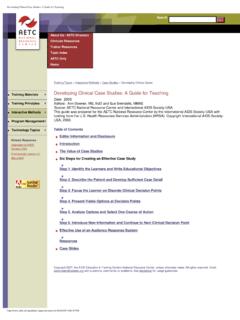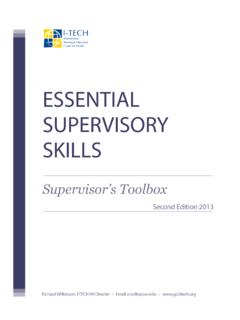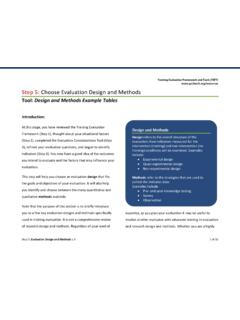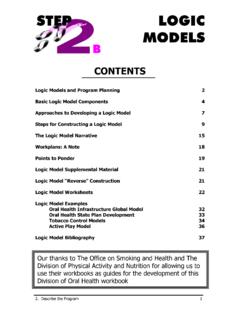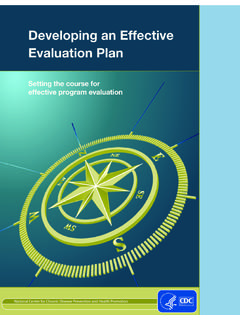Transcription of Building a Training Program - go2itech.org
1 Building a Training Program A Workshop presented to [Insert audience's name here]. _____. [Insert trainer's name here]. [Insert date/year of Training here]. [Insert location of Training here]. Building global capacity to improve the care of people living with HIV/AIDS. Learning Goals At the end of this workshop, you will be able to: Assess the needs of your learners. Design a Training plan that meets the needs of your learners. Develop a Training Program based on a Training plan. Implement a Training Program that you develop. Evaluate the Training Program based on whether the needs of your learners have been met. Building global capacity to improve the care of people living with HIV/AIDS. Training Development Model This workshop was designed using a common instructional systems design (ISD) model known as ADDIE: Assessment: What do your learners need to know to accomplish job-related tasks?
2 Design: What will your Training Program look like? Development: What content, learning methods, and resources will you need? Implementation: Can you deliver the Training Program effectively? Evaluation: How will you know if the Training Program is meeting/has met the needs of your Building global capacity to improve the care of learners? people living with HIV/AIDS. Creating a Training Program using the ADDIE Model Needs Assessment Training Design o What are the learners' job- related needs? o What learning outcomes will o What existing knowledge do meet learners' needs? they have? o What kind of Training plan o What is the gap between The Adult Learner needs to be created? what they know and what o What do they expect? o What resources are available? they need to know? o What do they need? o What are some potential o How can Training meet their learning challenges to this Training ?
3 Needs? o How can I as an trainer help them meet their learning needs? Training Implementation Training Development o What content needs to be o Are selected trainers ready to created? deliver the Training ? o What appropriate activities need o Are all Training resources to be developed? prepared and details regarding o What formative and evaluation the Training addressed? instruments need to be created? Evaluation o Are the needs of learners being addressed in the design and development of the Training ? o What methods are working/not working during implementation? o How did learners evaluate the Training upon completion? o How will you determine if learners are applying their learning as they carry out job-related tasks? Training Design August 2004. Workshop Outline Each section of the workshop will include the following four components: Introduction to the ADDIE component Explanation and discussion of the component Short exercises Summary Quiz Your questions are welcome throughout the workshop.
4 Building global capacity to improve the care of people living with HIV/AIDS. Building a Training Program Assess: What do your learners need to know to accomplish job-related tasks? Design Develop Implement Building global capacity Evaluate to improve the care of people living with HIV/AIDS. Needs Assessment Primary questions to answer when conducting a Training needs assessment: Who are adult learners? What kinds of learning experiences do learners need? What styles of learning do they bring to the Training Program ? What HIV+-related and job Training experience do they have? What do they need to know to carry out job- related tasks? What gap exists between what they know and what they need to know? Building global capacity to improve the care of people living with HIV/AIDS. Assessing the Adult Learner Major characteristics of adult learners as related to Training : Need to Know: Want Training delivered when they need it, when ready to progress to a new task or next stage.
5 Self Concept: Desire to be recognized by instructor as independent and self-directed. Life Experience: Expect instructor to recognize their prior accomplishments and knowledge. Task-centered and Practical: Training should help them meet job-related needs. Internally Motivated: Largely (but not Building global capacity to improve the care of exclusively) driven by internal rewards and people living with HIV/AIDS. not, for example, grades or parental approval. th Knowles, M., The Adult Learner (5 ed), 1998, Houston, TX: Gulf Publishing Assessing Learning Styles*. Four categories of learning experiences or styles: Doer: Like to be actively involved in learning process, want to know how they will apply learning in real world, like information presented clearly and concisely. Feeler: People-oriented, expressive, focus on feelings and emotions, thrive in open, unstructured learning environment.
6 Thinker: Rely on logic and reason, like to share ideas and concepts, analyze and evaluate, enjoy independent work. Observer: Like to watch and listen, tend to be reserved, will take their time before Building global capacity to improve the care of participating, thrive on learning through people living with HIV/AIDS. discovery. Lawson, K., The Trainer's Handbook, 1998, San Francisco, CA: Jossey-Bass. Training Methods & Learning Styles F. Doer Feeler Practice Personal Experience Apply concepts Role plays Simulations Group exercises Strive for D O. Variety Thinker Observer Reading Lectures Questioning Discussion Independent activities Problem solving T. Exercise Assess your own learning style by taking the Learning Style Inventory. Building global capacity to improve the care of people living with HIV/AIDS. Personal Learning Styles Inventory Instructions: For each of the numbered items below, rank alternatives a through d by assigning 4 to the phrase that is most like you, 3 to the one that next describes you, 2 to the next, and finally, 1 to the response that is least like you.
7 Add up your scores for each response at the bottom of this sheet. Ranking solving a problem, I prefer to a.) take a step-by-step approach b.) take immediate action c.) consider the impact on others d.) make sure I have all the facts 2. As a learner, I prefer to a.) listen to a lecture b.) work in small groups c.) read articles and case studies d.) participate in role plays 3. When the trainer asks a question to which I know the answer, I. a.) let others answer first b.) offer an immediate response c.) consider whether my answer will be received favorably d.) think carefully about my answer before responding 4. In group discussions, I. a.) encourage others to offer their opinions b.) question others' opinions c.) readily offer my opinion d.) listen to others before offering my opinion 5. I learn best from activities in which I.
8 A.) can interact with others b.) remain uninvolved c.) take a leadership role d.) can take my time 6. During a lecture, I listen for a.) practical how-to's b.) logical points c.) the main idea d.) stories and anecdotes 7. I am impressed by a trainer's a.) knowledge and expertise b.) personality and style c.) use of methods and activities d.) organization and control Page 1 of 2. Learning Styles Inventory (cont.). 8. I prefer information to be presented in the following way a.) model such as a flow chart b.) bullet points c.) detailed explanation d.) accompanied by examples 9. I learn best when I. a.) see relationships betweewn ideas, events, and situations b.) interact with others c.) receive practical tips d.) observe a demonstration or video 10. Before attending a Training Program , I ask myself, "Will I ?". a.) get practical tips to help me in my job b.
9 Receive lots of information c.) have to participate d.) learn something new 11. After attending a Training session, I. a.) tend to think about what I learned b.) am anxious to put my learning into action c.) reflect on the experience as a whole d.) tell others about my experience 12. The Training method I dislike the most is a.) participating in small groups b.) listening to a lecture c.) reading and analyzing case studies d.) participating in role plays Feelers Observers Thinkers Doers 1c 1 a 1 d 1 b 2b 2 a 2 c 2 d 3c 3 a 3 d 3 b 4a 4 d 4 b 4 c 5a 5 b 5 d 5 c 6d 6 c 6 b 6 a 7b 7 d 7 a 7 c 8d 8 a 8 c 8 b 9b 9 d 9 a 9 c 10 d 10 c 10 b 10 a 11 d 11 c 11 a 11 b 12 c 12 a 12 d 12 b TOTALS. Feelers Observers Thinkers Doers From Lawson, K., The Trainer's Handbook , 1998, San Francisco, CA: Jossey-Bass. Page 2 of 2. Learning Styles From Lawson, K.
10 , The Trainer's Handbook, 1998, San Francisco, CA: Jossey-Bass. Four Categories of Learning Experiences or Styles Doer: Like to be actively involved in learning process, want to know how they will apply learning in real world, like information presented clearly and concisely. Feeler: People-oriented, expressive, focus on feelings and emotions, thrive in open, unstructured learning environment. Thinker: Rely on logic and reason, like to share ideas and concepts, analyze and evaluate, enjoy independent work. Observer: Like to watch and listen, tend to be reserved, will take their time before participating, thrive on learning through discovery. Training Methods & Learning Styles F. Feeler Doer Practice Personal Experience Apply concepts Role plays Simulations Group exercises Strive for D O. Variety Thinker Observer Reading Lectures Questioning Discussion Independent activities Problem solving T.

